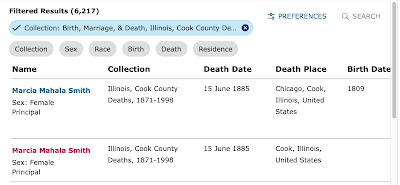Here is an example of an out-of-town death certificate for Flora Smith who died in Kansas City, Missouri. Notice that it's neatly written on a City of Chicago death certificate form. And notice that it only includes basic information: name, sex, color, age, death date, place of death, place of burial, undertaker, cause of death, and a physician’s name and address.

"Out of town deaths, 1909-1915," FamilySearch (https://www.familysearch.org/search/catalog/280109 : accessed 22 October 2017) > series 4, nos. 1-1490, Jan.-Sept. 1912, microfilm 1298897 > digital folder 004005117 > image 51, Flora Smith, no. 45 (11 January 1912).
Now compare the death certificate that was created for Flora in Missouri. The information on this record was recorded in two or more hands and it is more extensive, including an occupation, birth place, parent names, what looks to be the signature of the physician, and the name of an informant who lived in Okla[homa].

"Missouri Death Certificates, 1910-1966," Missouri Digital Heritage https://www.sos.mo.gov/mdh : accessed 21 October 2017) > Missouri Digital Heritage > Quick Links > Missouri Birth > Death Records Database, Pre-1910 > Missouri Death Certificates, 1910 - 1966 > entry for Flora Smith, file no. 1241 (11 January 1912).
I don’t know how the Chicago record was created but my guess is that the information was copied from the Missouri death certificate, a burial permit, and/or a transport document. Compare the physician’s signatures, though. Clearly, the Chicago certificate is a derivative record.
I’m not sure why the Chicago record was created, but because it has minimal information, my sense is that it was intended to document the burial.
Notice how the two records work together to tell the story of Flora’s life, death, and burial. The Missouri death certificate tells us her occupation, lists her parents, provides an exact place of death, indicates the coroner was called, and gives her place of burial or removal as “Chicago Ill.” The Chicago record leaves off many of those details, but it adds an important piece of information—the cemetery name.
How to Locate the Out-of-town Death Certificates
The approach to locating these certificates depends on what you know.
Browse
If you have a death certificate from somewhere other than Chicago for a death that occurred between 1909 and August 1915, then you can go directly to the FamilySearch catalog entry for Out of Town Deaths, 1909-1915 and pick the correct film based on the death date. The records are grouped by death date and it shouldn't be too hard to browse the images to see if there's a matching record there.
Locate the Certificate Number
A more direct way to access these records is to locate the matching entry in the Chicago Death Index, 1871-1933 that I discussed in a previous blog post. (The images are available online at FamilySearch if you visit a Family History Center or affiliate library.) These certificates are listed in this index as "OT" (for out-of-town) and the register number matches the records on the films.
Here is the entry for Flora. Note the register number, "45" in the next-to-last column, is the same as the number on the top right corner of her Chicago certificate. The records are arranged in numerical order on the film (or the images created from the film) and this can save time in finding the correct record.

"Indexes to deaths in the city of Chicago during the years 1871 to 1933 : showing name, address and date of death," FamilySearch (https://www.familysearch.org/search/catalog/293534 : accessed 22 October 2017) > Deaths, Sik-Ste 1871-1933, microfilm 1295974 > digital folder 004261177 > image 51, Flora Smith (11 January 1912).











